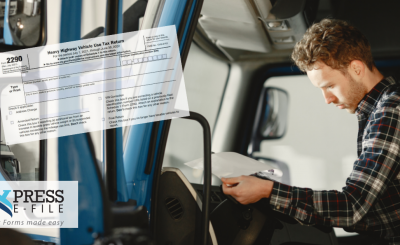Whether you’re managing a fleet of vehicles or driving solo, here’s what you need to know about HVUT Form 2290 to keep your business safe and in good standing with the IRS.
What is Form 2290?
Form 2290 is the Heavy Vehicle Use Tax Return. This form and the yearly payment that goes with it allow your truck to keep cruising on the road. Even though you’re dropping some cash upfront, it ends up being an investment in your business, since 2290 tax payments go to construction, maintenance, and keeping the highways running smooth.
Who has to file Form 2290?
Almost everyone who owns a vehicle that weighs in at 55,000 pounds or more has to file this form every year. There are a few exceptions for blood collection and off-highway non-transportation vehicles, but when it comes to the trucking industry, filing IRS Form 2290 comes with the job.
Does it matter how far I drive?
Driving under 5,000 miles a year is the only way to get away with not paying your HVUT for a commercial vehicle that weighs over 55,000 pounds. Even if you don’t need to make a payment to the IRS, you still have to file Form 2290 and have the IRS stamped Schedule 1 for your vehicle.
If your vehicle is agricultural, you have to drive 7,500 miles or less in a year to remain exempt from paying the HVUT.
If you make a payment but end up traveling under 5,000 miles, you can get your money back. When the next tax period rolls around you can either get an electronic refund from the IRS.
When is the Form 2290 deadline?
The deadline for Form 2290 is typically August 31. It’s determined from the first month your truck is on the road, so If you operate from July 1 to June 30, August 31 is the due date. If you are driving a newly purchased vehicle and your first use month (FUM) is not July, your deadline is the end of the month following your FUM.
What do I need to file Form 2290?
In order to file Form 2290 with the IRS, there are a few things you’ll want to have on hand.
EIN
When you file Form 2290, you will need an Employer Identification Number. Unfortunately, you can’t substitute your Social Security Number or anything else, but if you don’t have an EIN yet, it’s easy to get. You can apply for an EIN in under ten minutes with our sister product TSNAmerica. Make a quick phone call to (803)386-0320. It usually takes the IRS around four weeks to get you set up, so if you need an EIN, give your 2290 deadline some following distance.
Vehicle Identification Number
You’ll need the identification number for all of your vehicles in order to file with the IRS. For trucks, this number is usually on the side panel of the cab door.
Taxable Gross Weight
It’s important to know how much your vehicle weighs. Taxable gross weight is the weight when your truck is unloaded but still has all of its accessories and equipment on board.
What Happens If I Don’t File?
Failure to file Form 2290 means you’ll owe the IRS even more money. The penalty is 4.5 percent of the total amount due. This fine can keep increasing for up to five months after the missed deadline.
If you don’t pay your HVUT, you will be fined .5 percent of the total tax and also a monthly interest charge of .54 percent.
Worst case scenario, you could eventually get your license revoked.
How Do I File IRS Form 2290?
You can file Form 2290 and pay your HVUT simply and safely with Express E-file. Our software navigates you through the filing process with helpful prompts, and you’ll get your stamped Schedule 1 back in minutes.
E-filing is required if you have 25 or more vehicles, but even if you only have one, it’s the IRS recommendation. Check out the top 5 reasons commercial drivers and trucking professionals choose to e-file.
If you have any questions, our support team is 100% US-based and happy to help. When you’re ready to file, Express E-file is here to make it simple.




